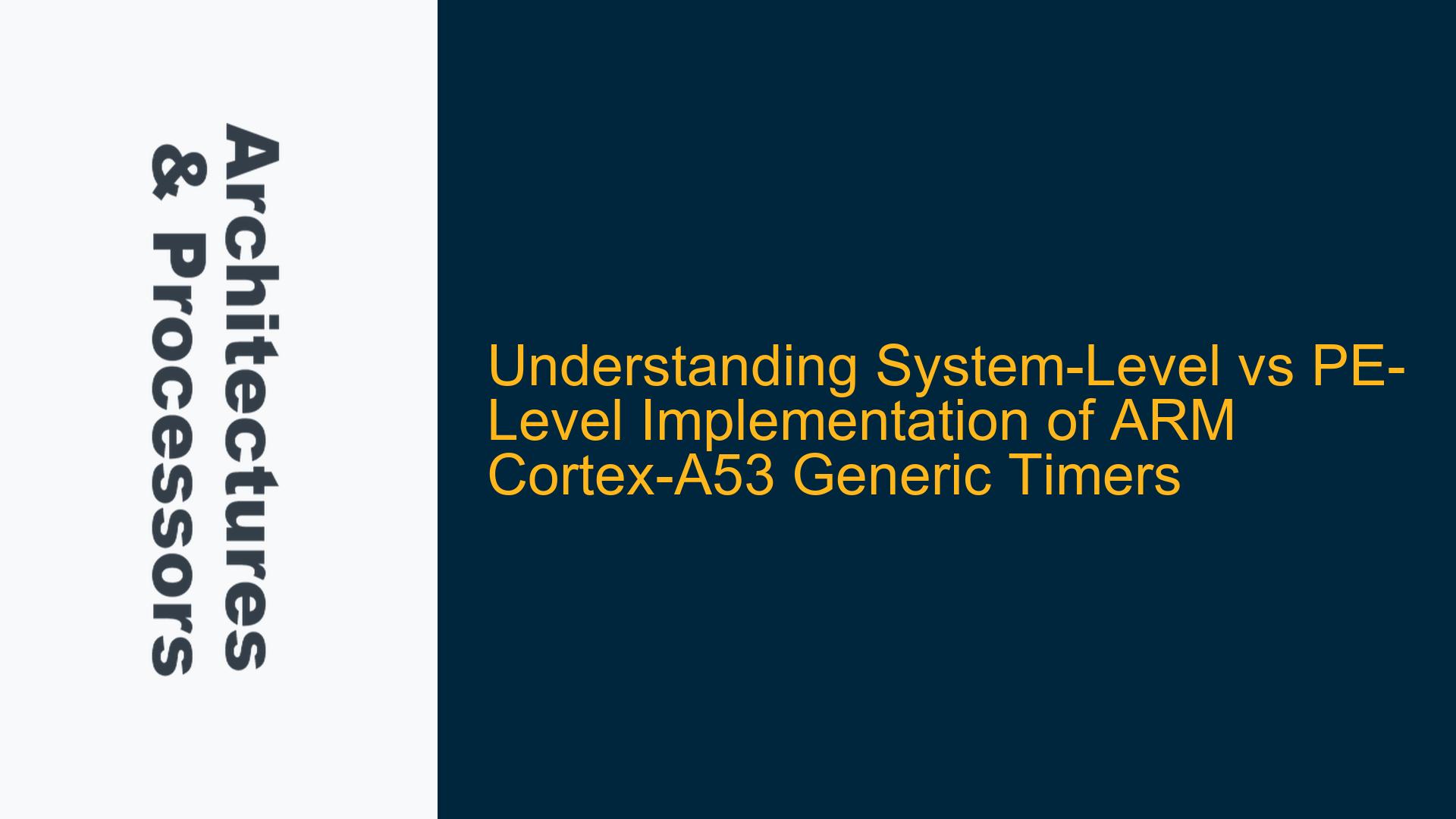System-Level vs PE-Level Generic Timer Implementation in ARM Cortex-A53
The ARM Cortex-A53 processor, a widely used 64-bit core in the ARMv8-A architecture, incorporates a Generic Timer that is essential for timekeeping, scheduling, and synchronization tasks. However, the implementation and operation of the Generic Timer can be understood at two distinct levels: the System Level and the Processing Element (PE) Level. These levels represent different scopes of functionality and responsibility within the system, and understanding their differences is critical for proper system design, debugging, and optimization.
At the System Level, the Generic Timer involves components that are shared across the entire System-on-Chip (SoC). These components are typically memory-mapped and accessible to all Processing Elements (PEs) within the system. Examples include the Global System Counter and associated control registers, which provide a unified timebase for the entire system. The System Level implementation ensures that all PEs have a consistent view of time, which is crucial for tasks such as inter-processor synchronization and system-wide event scheduling.
At the PE Level, the Generic Timer involves components that are specific to each individual Processing Element. These components are accessed via dedicated instructions such as MRS (Move to Register from System Register) and MSR (Move to System Register from Register). Examples include the Counter-Timer Frequency Register (CNTFRQ_EL0) and the Physical Timer CompareValue Register (CNTP_CVAL_EL0). These registers allow each PE to maintain its own timer state, enabling fine-grained control over local timing operations.
The distinction between System-Level and PE-Level implementations becomes particularly important when considering the differences between AArch64 and AArch32 states. In AArch64, the Generic Timer is fully supported with a rich set of system registers and features, while in AArch32, certain functionalities may be limited or require additional software emulation. Understanding these nuances is essential for developers working on systems that need to operate in both states or transition between them.
Memory-Mapped vs PE-Accessible Timer Components
The Generic Timer in ARM Cortex-A53 relies on a combination of memory-mapped and PE-accessible components to provide its functionality. Memory-mapped components are part of the System-Level implementation and are accessed through the system’s memory bus. These components include the Global System Counter and its associated control registers, which are shared across all PEs in the system. The Global System Counter provides a consistent timebase that is essential for synchronizing activities across multiple PEs.
PE-accessible components, on the other hand, are part of the PE-Level implementation and are accessed via dedicated instructions such as MRS and MSR. These components include the Counter-Timer Frequency Register (CNTFRQ_EL0), which defines the frequency of the system counter, and the Physical Timer CompareValue Register (CNTP_CVAL_EL0), which is used to set the compare value for the physical timer. These registers are specific to each PE and allow for fine-grained control over local timing operations.
The interaction between memory-mapped and PE-accessible components is critical for the proper functioning of the Generic Timer. For example, the Global System Counter, which is memory-mapped, provides the timebase for all PEs, while the PE-accessible registers allow each PE to configure its own timers based on this timebase. This division of responsibilities ensures that the system can maintain a consistent view of time while still allowing individual PEs to perform local timing operations.
One common issue that arises in this context is the potential for inconsistencies between the System-Level and PE-Level components. For example, if the Global System Counter is not properly synchronized across all PEs, it can lead to timing discrepancies that affect system performance and reliability. Similarly, if the PE-accessible registers are not configured correctly, it can result in incorrect timer behavior on individual PEs. Understanding the relationship between these components and ensuring their proper configuration is essential for avoiding such issues.
Troubleshooting Generic Timer Configuration and Synchronization Issues
When working with the Generic Timer in ARM Cortex-A53, developers may encounter issues related to configuration, synchronization, and operation. These issues can manifest as incorrect timing behavior, system crashes, or performance bottlenecks. To address these issues, it is important to follow a systematic approach that includes verifying the configuration of both System-Level and PE-Level components, ensuring proper synchronization between PEs, and debugging any discrepancies that arise.
The first step in troubleshooting Generic Timer issues is to verify the configuration of the Global System Counter and its associated control registers. This includes checking that the counter frequency is set correctly and that the counter is enabled and running. The frequency of the Global System Counter is typically set by the firmware or bootloader during system initialization, and it is important to ensure that this value matches the expected frequency for the system. If the counter frequency is incorrect, it can lead to timing discrepancies that affect the entire system.
Next, it is important to verify the configuration of the PE-accessible registers, such as the Counter-Timer Frequency Register (CNTFRQ_EL0) and the Physical Timer CompareValue Register (CNTP_CVAL_EL0). These registers should be configured to match the frequency of the Global System Counter and to set the appropriate compare values for the physical timer. If these registers are not configured correctly, it can result in incorrect timer behavior on individual PEs.
Another common issue is the lack of proper synchronization between PEs. This can occur if the Global System Counter is not properly synchronized across all PEs, leading to timing discrepancies that affect system performance and reliability. To address this issue, it is important to ensure that the Global System Counter is properly initialized and that all PEs are synchronized to the same timebase. This can be achieved by using synchronization mechanisms such as barriers or by explicitly synchronizing the PEs during system initialization.
In some cases, issues may arise due to differences between the AArch64 and AArch32 states. For example, certain Generic Timer features may not be available in AArch32, or they may require additional software emulation. In such cases, it is important to ensure that the system is properly configured to handle these differences and that any necessary software emulation is implemented correctly.
Finally, it is important to use debugging tools and techniques to identify and resolve any discrepancies that arise. This may include using hardware debuggers to inspect the state of the Global System Counter and PE-accessible registers, or using software tools to trace the execution of timer-related code. By following a systematic approach and using the appropriate tools, developers can effectively troubleshoot and resolve Generic Timer issues in ARM Cortex-A53 systems.
In conclusion, the Generic Timer in ARM Cortex-A53 is a complex and powerful feature that requires careful configuration and synchronization to ensure proper operation. By understanding the differences between System-Level and PE-Level implementations, verifying the configuration of memory-mapped and PE-accessible components, and following a systematic approach to troubleshooting, developers can effectively address issues related to the Generic Timer and ensure the reliable operation of their systems.






